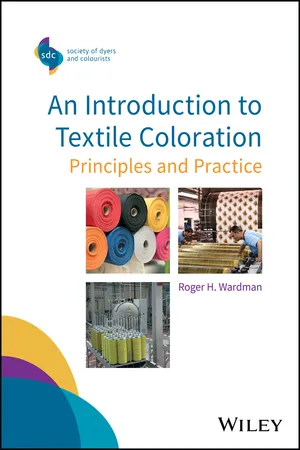
- English
- ePUB (mobile friendly)
- Available on iOS & Android
About This Book
An Introduction to Textile Coloration: Principles and Practice
The Publications Committee of the Society of Dyers and Colourists (SDC) has been aware for some time of the need to produce a book at an introductory level aimed at personnel working in textile dyeing or printing companies as well as those interested in entering into the field. The SDC runs a course for dyehouse technicians leading to the award of its Textile Coloration Certificate and this book is intended to be helpful for candidates following the course. Additionally, it will be helpful for professionals in textile companies who do not have a strong scientific background, so that they may attain a better understanding of the chemical principles of colour application.
Starting with the basic science underlying dyeing and printing processes, this comprehensive book explains the fundamentals of dye and pigment chemistry and the various application techniques and processes. It offers chapter coverage of the general chemistry related to textiles, textile fibres, chemistry of dyes and pigments, industrial coloration methods, textile printing, theoretical aspects of dyeing, the measurement of colour and fastness testing. Reference is made to developments that have taken place in the coloration industry in recent years, not least of which have been the challenges imposed by the drive towards environmentally-friendly processes and restrictions on the use of certain chemicals.
An Introduction to Textile Coloration: Principles and Practice
- Covers atomic structure, chemical reactions, and acids, bases, and salts
- Explains the nature of fibre-forming polymers and the conversion of synthetic polymers into fibre filaments
- Educates on the classification of colorants and the commercial naming of dyes and pigments
- Introduces readers to the dye application processes and dyeing machinery
- Instructs on dye aggregation, factors affecting colour appearance, the principles of colour fastness testing, and more
"…this is the sort of book any dyer, technician, student, academic will want to always have as an ready reference to everything pertaining to textile coloration."
Richard S. Blackburn, School of Design, University of Leeds, Leeds, LS2 9JT, UK
Frequently asked questions
Information
1
General Chemistry Related to Textiles
1.1 Introduction
1.2 Atomic Structure
Table of contents
- Cover
- Title Page
- Table of Contents
- Society of Dyers and Colourists
- Preface
- 1 General Chemistry Related to Textiles
- 2 Textile Fibres
- 3 Chemistry of Dyes and Pigments
- 4 Industrial Coloration Methods
- 5 Textile Printing
- 6 Theoretical Aspects of Dyeing
- 7 The Measurement of Colour
- 8 Fastness Testing
- Appendix: Some Textile Terms and Definitions
- Index
- End User License Agreement